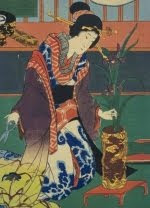Today, as I was going through some old papers, I found a sheet with notes from a lecture with Dr. Nancy Stalker, from her visit in Oslo last year. Dr. Stalker is a professor of Japanese history and culture at the University of Texas at Austin. One of her present research topics is the role of ikebana in constructing national and international Japanese identity in the twentieth century, especially focusing on its rapid expansion in postwar Japan from the 1950s-70s.
DR. Stalker states that Ikebana played an important role in the postwar recovery of Japan. The new Japan was branded as a nation balancing industrial "hard power" with artistic "soft power". In this marketing as a nation of culture, ikebana became a pillar of cultural nationalism. A state agency Ikebana Geijutsu kyôkai (Japan Ikebana Association), was established to coordinate and encourage the development of the schools. About 110 schools joined the agency, that came to work almost like a cartel dominated by the three largest schools, Ikenobo, Ohara and the new and rapidly growing Sogetsu school.
 |
| The Sogetsu Kaikan building 1958, designed by Tange Kenzo. |
The iemoto system was challenged also by the growth of ikebana outside of Japan. In the 1960s approximately 10.000 foreign women held ikebana teachers exams from different schools and were teaching around the world. The organisation Ikebana international was founded 1956 by Ellen Gordon Allen. Ikebana international organizes people interested in ikebana from different schools and encourages exchange between the traditions, a totally unthinkable idea within the iemoto system. Traditionally you work towards the perfection of your skills within your own school, following the rules set up by the iemoto. With a forceful personality and many colorful friends, Ellen Gordon Allen managed to develop a strong organisation and her ideas forced the schools to transform the traditions towards more openness. The iemotos realized that they could profit from adjusting to a more international approach.












2 comments:
That was interesting to read how the formation of Ikebana International affected the Iemoto system. Thanks for this post.
Thanks Gail. The iemoto system is different from what we're used to. It's interesting to see that it has been flexible enough to adjust to continue to make sense.
Post a Comment